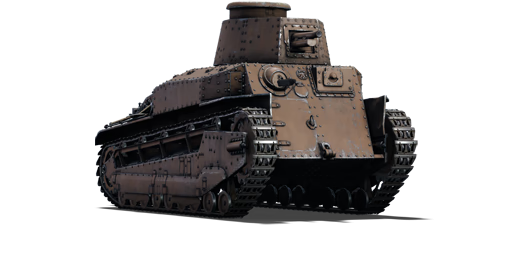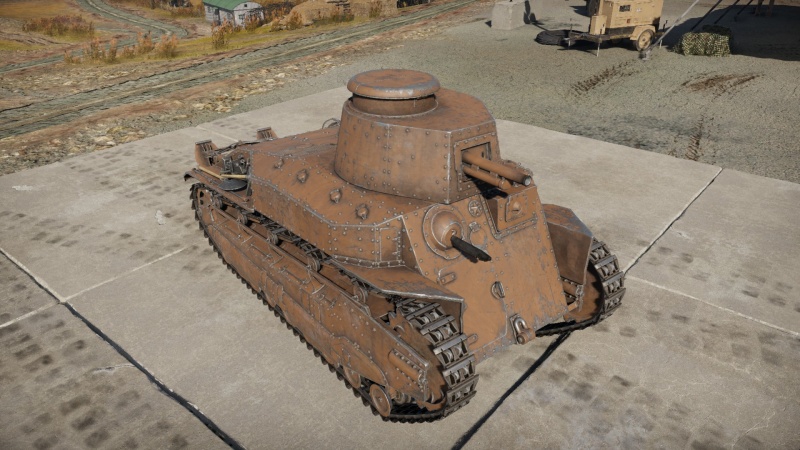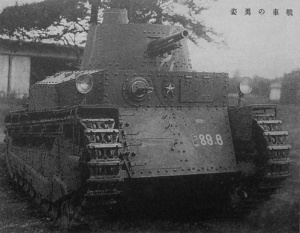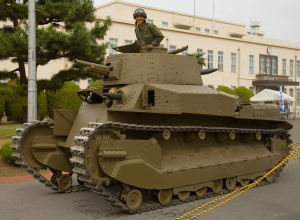I-Go Ko
| This page is about the Type 89 I-Go. For equipment of the same adoption year, see Type 89 (Disambiguation). |
Contents
Description
The Type 89b I-Go Ko is a reserve rank I Japanese light tank with a battle rating of 1.0 (AB/RB/SB). It was introduced in Update 1.65 "Way of the Samurai" along with the rest of the initial Japanese Ground Forces Tree.
The I-Go Ko is a quite average starting tank, not being absolutely awful but not exactly great either. The tank's armour is virtually non-existent, the engine has good acceleration but caps out at 27 kph, and the gun has decent APHE rounds but with less penetration than the 37 mm Type 94 - the only round really worth using is the HEAT rounds, which perform substantially better. Even so, the gun does have a considerable drop-off, so take care when aiming. All in all, the tank is a jack-of-all-trades, master of none for Rank I.
General info
Survivability and armour
Armour on the I-Go Ko is considered quite lacking against contemporary enemies, which is to say that it may as well not exist. At armour thickness all less than 20 mm (aside from the spaced areas), even large-calibre machine guns can penetrate the armour. Not to mention, the front armour of 17 mm is only mildly sloped and presents a large hull target that can knock out every crew with a single penetration. Never rely on your armour, never advance on an enemy unless they are incapacitated (i.e. gunner or cannon knocked out).
Armour type:
- Rolled homogeneous armour
| Armour | Front | Sides | Rear | Roof |
|---|---|---|---|---|
| Hull | 17 mm (32°) Front glacis | 17 mm Top 17 + 17 mm Bottom |
17 mm (61°) Top 17 mm Bottom |
10 mm |
| Turret | 17 mm (9°) Turret front 25 mm (10°) Gun mantlet |
15 mm (10-12°) | 15 mm (11°) | 10 mm |
| Armour | Sides | Roof | ||
| Cupola | 15 mm | 10 mm |
Notes:
- Suspension wheels and tracks are both 15 mm thick.
Mobility
| Game Mode | Max Speed (km/h) | Weight (tons) | Engine power (horsepower) | Power-to-weight ratio (hp/ton) | |||
|---|---|---|---|---|---|---|---|
| Forward | Reverse | Stock | Upgraded | Stock | Upgraded | ||
| Arcade | 30 | 5 | 11.1 | 183 | 225 | 16.49 | 20.27 |
| Realistic | 27 | 4 | 104 | 118 | 9.37 | 10.63 | |
Like the armour, the I-Go Ko leaves much to be desired in the tank's top speed that limits the utility of the quick acceleration. That's not the say that the tank is not maneuverable, rather, the opposite - the tank can turn and accelerate quite well. It's just the top speed that lets you down.
Modifications and economy
Armaments
Main armament
| 57 mm Type 90 | Turret rotation speed (°/s) | Reloading rate (seconds) | |||||||||||
|---|---|---|---|---|---|---|---|---|---|---|---|---|---|
| Mode | Capacity | Vertical | Horizontal | Stabilizer | Stock | Upgraded | Full | Expert | Aced | Stock | Full | Expert | Aced |
| Arcade | 100 | -15°/+20° | ±180° | Vertical | 14.47 | 20.03 | 24.32 | 26.90 | 28.61 | 4.29 | 3.80 | 3.50 | 3.30 |
| Realistic | 9.04 | 10.64 | 12.92 | 14.30 | 15.20 | ||||||||
Ammunition
| Penetration statistics | |||||||
|---|---|---|---|---|---|---|---|
| Ammunition | Type of warhead |
Penetration @ 0° Angle of Attack (mm) | |||||
| 10 m | 100 m | 500 m | 1,000 m | 1,500 m | 2,000 m | ||
| Type 92 APHE | APHE | 21 | 21 | 19 | 16 | 14 | 13 |
| Type 3 HEAT | HEAT | 55 | 55 | 55 | 55 | 55 | 55 |
| Shell details | |||||||||
|---|---|---|---|---|---|---|---|---|---|
| Ammunition | Type of warhead |
Velocity (m/s) |
Projectile Mass (kg) |
Fuse delay (m) |
Fuse sensitivity (mm) |
Explosive Mass (TNT equivalent) (g) |
Ricochet | ||
| 0% | 50% | 100% | |||||||
| Type 92 APHE | APHE | 349 | 2.58 | 1.2 | 9 | 103 | 47° | 60° | 65° |
| Type 3 HEAT | HEAT | 380 | 1.8 | 0 | 0.1 | 303.36 | 62° | 69° | 73° |
Ammo racks
| Full ammo |
1st rack empty |
2nd rack empty |
3rd rack empty |
4th rack empty |
5th rack empty |
Visual discrepancy |
|---|---|---|---|---|---|---|
| 100 | 97 (+3) | 61 (+39) | 49 (+51) | 13 (+87) | 1 (+99) | No |
Recommendations: The ammo racks in the I-Go Ko are rather small due to the small ammunition, and so could be hard in a casual engagement unless aimed for directly, which would be rare given the thin armour on the tank encouraging center-mass shots rather than targeted hits.
However, to minimize racks to avoid detonation, emptying all the way to the 3rd rack at 49 total rounds will leave only two rather small racks remaining. If wanting to bring in more ammunition, removing only the ammo rack in the turret at 97 rounds will leave plenty.
Machine guns
The Type 91 machine gun is mounted at the hull with limited traverse all-around. With a limited ammo per belt, the machine gun doesn't serve much except as a possible harassing tool against enemies in front.
| 6.5 mm Type 91 | ||||
|---|---|---|---|---|
| Mount | Capacity (Belt) | Fire rate | Vertical | Horizontal |
| Hull | 3,000 (30) | 499 | ±22° | ±25° |
Usage in battles
The Type 89b I-Go Ko, despite its rather sluggish looks, is a mobile tank that could use its speed to get to an enemy's flanks and cause some serious damage. The 57 mm cannon is unfortunately rather pitiful even in Rank I, with a penetration value of between 20 to 30 mm at standard combat ranges. Thus, it is best to catch an enemy by its sides in order to get through their weaker side armour. The 57 mm low-velocity shell does have an advantage of a rather prominent parabolic trajectory so it is possible to lob shells over hills to hit unsuspecting enemies behind it. This, fortunately, has changed with the addition of a High Explosive Anti-Tank (HEAT) shell which is available for this vehicle and all Japanese tanks that use the 5.7cm Type 97 cannon. This shell has 55mm of penetration at any range but still has considerable drop-off due to the low-velocity of the gun. It's a good enough anti-everything that can penetrate most targets you will meet, especially those pesky French tanks, which tend to be quite well armoured. The Type 3 HEAT shell, fortunately, has just enough penetration to get through them, although one should always try to aim for weak spots and never assume that you will penetrate no matter what.
Pretty much everything is a threat to this vehicle. Fast vehicles (BT-7, BT-5, M2A1, Tetrarch, T-60) in particular are an uneasy encounter: The I-Go is reasonably fast at close quarters, but not that fast. At close range, the I-Go's poor turret turning speed cannot follow the movement and at long range, the slow shells are a pain to aim precisely at a moving target - especially seeing as the 45mm 20-K that virtually every Soviet vehicle at this BR has can easily kill you at any range with a well-aimed shot. Autocanons (72-K GAZ AAA, Pz. II, Flakpanzer, Gepard, M13, T17E2, etc.) are the I-Go Ko's worst nightmare since they can make mincemeat of the armour in seconds without too many efforts. Plus, they are often quite fast.
Pros and cons
Pros:
- Decent forward speed
- Parabolic trajectory allows 57 mm round to hit over hills
- APHE has a huge amount of explosive mass, especially for the calibre
- Great gun depression
- Type 3 HEAT shell can get though most tanks you meet rather easily
Cons:
- Weak overall armour of 17 mm, vulnerable to any armament
- 57 mm armament has very low muzzle velocity and penetration - can struggle to hurt many of the tanks it will face, even from the sides
- Slow traverse speed even when upgraded
- Rather tall as a Rank I tank (not as bad as LVT(A)(1) though)
- Machine gun only fires forwards in a limited arc
- The only tank that isn't a threat to you is the Light Tank mk. VI AA (rank I British SPAA)
History
Development
Japan's early pioneering into the concept of armoured warfare began as early as October 1918 during the first World War. They were able to acquire a few tank samples from the European governments, ranging from a British Mark IV tank, Medium A Whippet tanks, and Renault FT tanks. These tanks would make up Japan's first tank units in 1925. Their experiences with these tanks led to the eventual development of their own domestic tank design. The requirement for this new tank was given to the 4th Military Laboratory under the Imperial Japanese Army's jurisdiction and was mainly in charge of land vehicle development. In the summer of 1926, the first prototype was completed with the design of three turrets, one main in the middle and two smaller ones in the front and rear. The design was deemed too heavy at 18 tons and so development restarted, the initial design carrying on in the failed Type 91 and 95 tanks. During this time, a trial with a British Vickers Model C tank had the tank's gasoline engine catch fire. This prompted the Japanese to fit their tanks with a diesel engine instead. The development led to a new design in 1929, titled Type 89 I-Go. Though it is considered to be a light tank, the designation changed to a medium tank due to its weight of 10 tons.[1]
The Type 89's construction was assigned to Sagami Arsenal, but it was subcontracted to private firms due to Sagami's lack in industry. One of the firms was Mitsubishi Heavy Industries, which developed a tank plant specifically for the Type 89. The Type 89 production officially started in 1931, with mass-production in 1933 and continued until 1939 with 404 tanks built.[1]
Design
The Type 89 I-Go was Japan's first domestic tank design, yet it showed a lot of features that were revolutionary and would become a trademark of the Japanese tank designs. The Type 89 I-Go had a four-man crew in the tank with two in the turret. The turret held a 57 mm low-velocity gun meant for fighting fortifications due to the tank's role as infantry support. A peculiar feature on the Type 89 was the rear machine gun on the back of the turret. This machine gun was meant to enable the Type 89 to engage forward targets with a machine gun or it's 57 mm gun and would be a design trend in future tank development.[1]
The Type 89 design changed gradually over time due to troop experience and advances in technology. For example, a small change that occurred for the Type 89 was the change of the commander's cupola from a "top hat" or "lid" design to a split hatch design. A noticeable change was in the engine when the first models produced off the lines were powered by a 118hp gasoline engine, these tanks were labelled as Type 89A I-Go Ko. It wasn't until 1934 when a change to 120hp Mitsubishi diesel engine was made that the Type 89 was redesignated the Type 89B I-Go Otsu. This diesel engine made the Type 89 the first mass-produced tank that uses diesel as its fuel.[1]
The Type 89 does carry its few flaws, however. The tank was quite slow at about 25 km/h (16 mph), a hindrance to mobile operations using motorized infantry that must wait for the tanks to reach the combat zone. The armour was quite thin at 17 mm and the 57 mm's anti-tank power was quite abyssal. However, against the Chinese troops from 1932 onwards, the armour and firepower flaws were small worries due to the lack of available tanks and anti-tank defences on the Chinese side.
Combat usage
The Type 89 was first used in 1932 in the 1st Special Tank Company after the Manchurian Incident. The company, armed with Type 89 along with Renault FT and NC tanks, took part in the conflict between China and Japan in the Shanghai Incident. The experience showed that the Type 89 performed well in comparison to the Renaults and soon the entire company was fitted with Type 89s, retiring the Renaults.[1]
The mass production of the Type 89 from 1933 onwards allowed the formation of large tank groups in Japan, leading to the 1st and 3rd Tank Regiment in Kurume, Fukuoka with the 2nd Tank Regiment at Chiba Tank School. The 1st Tank Regiment would be deployed with the Kwantung Army in China, where it would carry the Type 89 tank in the conflict against China from 1937 onwards.[1]
By 1939, the Type 89 was starting to be succeeded by newer Japanese tanks, but they still served on the frontlines such as the border conflicts between Japan and the Soviet Union. In the Battle of Khalkhin Gol, the IJA's 1st Tank Corps attacked the Soviet 11th Tank and 7th Armoured brigades in July with a mixture of Type 89s, Type 97 mediums, Type 95 lights, and tankettes in the 3rd and 4th Tank Regiments. Though the attack stirred up Soviet lines, there was no breakthrough in Soviet lines. The Soviets, armed with T-26 and BT light tanks, would soon push the Japanese back to Manchuria and have a cease-fire signed on 24 August.
Though the Type 89 was mostly withdrawn from service and replaced with the Ha-Go and Chi-Ha, the I-Go still served as far into the battles for the Philippines, Malaya and Burma. Some tanks saw further use as static pillboxes in the Japanese islands of the Pacific, but these tanks were vulnerable to newer anti-tank and tank technology of the Americans with their bazookas and M4 Shermans once they started their island-hopping strategy against Imperial Japan.
Even after World War II, some Type 89s were still seen in service of the French during the First Indochina War, using the captured Japanese armour in a unit known as 'Commando Blindé du Cambodge'.
Surviving Tanks
Many Type 89 relics still are visible in the wild usually reduced to a wreck with a handful of tanks still being in a good condition. These in good condition are located in:
- The Ordnance Training Support Facility, Ft. Lee, VA, USA.
- The Japanese Ground Self-Defense Force base at Tsuchiura, Ibaraki, Japan.
- Sinbudai Old Weapon Museum, Camp Asaka, Japan
- Villa Escudero, Tiaong, Quezon Province, Philippines
Only 1 I-Go Otsu remains in running condition, which was restored at the JGSDF base at Tsuchiura together with the last Type 3 Chi-Nu to still exist. Both are stored on military ground so aren't at all times in public display. The I-Go Otsu usually makes an appearance during the open day of the Tsuchiura base. The vehicle can be seen in media still running after being restored by the JGSDF.
Media
- Videos
- In-Game
- Historical
References
See also
Links to the articles on the War Thunder Wiki that you think will be useful for the reader, for example:
- reference to the series of the vehicles;
- links to approximate analogues of other nations and research trees.
External links
| Japan light tanks | |
|---|---|
| Type 89 | I-Go Ko |
| Type 95 | Ha-Go · Ha-Go Commander |
| Type 98 | Ke-Ni |
| Other | Ka-Mi |
| IFV | Type 89 |
| RCV | Type 87 RCV (P) · Type 87 RCV · RCV (P) |
| MCV | Type 16 (P) · Type 16 (FPS) · Type 16 |
| USA | ▅M24 · ▅M41A1 |







